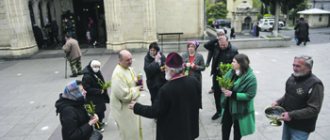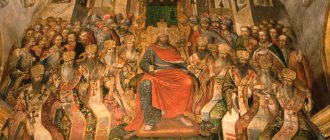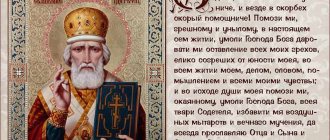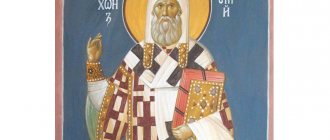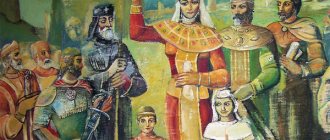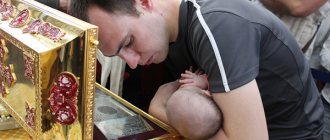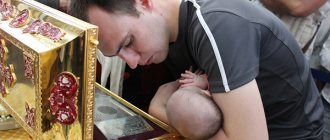They looked at this house day and night, holding icons and candles, whispering prayers and crossing themselves. Passersby tried in vain to understand what was special about this building - in the eyes of many, indistinguishable from all the gray Soviet-built apartment buildings surrounding it. Last December, when I finally worked up the courage to ask what was going on inside, one of the women standing there—her head, like most of the others, covered with a headscarf in the manner of Orthodox nuns—replied with blissful confidence: “God lives there.” "
In his earthly incarnation, the inhabitant of the house on Tbilisi's Barnovi Street is Nikoloz Makarashvili, a self-proclaimed priest whom fans know as “Monk Nariman.”
In Georgia - according to sociological surveys, the most God-fearing country in Europe - Nariman became the latest of the national saints to win the love of believers. His followers claim that Nariman performs miracles almost every day, and his touch cures diseases such as pneumonia and glaucoma.
Influential church authorities disagree: in 2021, the Georgian Orthodox Church announced his excommunication, citing vague “health problems.” But even after being officially defrocked, Nariman continues to wear church vestments and retains a zealous flock. He became a city hermit, took a vow of silence and secluded himself in his home in the center of the city; he lives on donations from his followers.
Due to a vow of silence, he does not give any interviews, but his followers readily testify for him. One of them, a lively middle-aged woman wrapped in a black shawl and a black headscarf, grabbed my hand to share her own story. “Son, last year I spent the whole winter here in prayer,” she said, mysteriously lowering her voice. “I prayed and prayed, and finally he looked out the window, and the next day,” here her voice broke with excitement, “spring came!”
Another believer told Eurasianet: “Georgia is very lucky because God chose us.”
Le Monde 04/09/2019 Civil.ge 03/28/2019 Ambebi 03/26/2019 Nariman communicates with the world by delivering letters to members of his makeshift parish, who then work to decipher the secret meaning of these messages. “I cut my hair and beard because I have problems in my brain,” Nariman wrote in one of the notes, according to a follower who read the letter to reporters from a local TV station. With these words, she continued, he commented on current political events. “The disease he is talking about here is political parties that block the sun over Georgia.” As his flock grew, what happened on Barnovi Street attracted more and more media attention. Journalists interviewed not only Nariman's followers, but also his neighbors. As it turned out, the residents of the house were not particularly enthusiastic about being in the neighborhood of the saint: they said that he threw garbage out of the window, and the constant presence of his admirers became tiresome.
On Christian holidays, a large crowd gathered outside the house to pray and sing hymns. The parishioners mostly prayed outside the building, but often crowded on the stairs, waiting for Nariman to show himself to them and convey his next message to the world.
Nariman's landlord said that he was behind on the rent, but the congregation fiercely resisted any attempts to evict him. There were repeated riots on Barnovi Street, which the police were called to pacify, until finally, at the end of that winter, the monk moved: he and his followers honored with their presence another house located on the outskirts of the city.
Nariman is not the first defrocked priest to harass Georgian authorities. In the 1990s and early 2000s, a certain Father Vasily Mkalavishvili led a crusade in defense of Orthodox Georgia from the heresy of Western Christianity. In 1996 he was excommunicated from the church, but this did not stop him. Together with him, his parishioners, armed with icons and wooden crosses, even persecuted and beat Jehovah's Witnesses* (an organization banned in Russia - editor's note), Baptists and other followers of “alien” confessions. Ultimately, in 2004, Vasily was arrested after a brutal police raid, with the police acting as brutally, if not more brutally, than a crowd of his own supporters.
Although the official Georgian Church disavows characters like Nariman and Vasily, some of the clergy recognized by the Church also have fanatical followers. The most notable of these priests was the monk Gabriel, another hermit who also had a reputation as a miracle worker.
Gabriel, the last of the Georgian saints, was canonized in 2012, seven years after his death. In 2014, his body was ceremonially removed from its grave in the country's spiritual capital, Mtskheta, to demonstrate that it remained completely incorrupt. A crowd of thousands gathered at the remains; There was such excitement that the military was brought in to maintain order.
The newly discovered saints of Georgia and eccentric forms of worship of them appeared on the wave of religious upsurge that arose after the collapse of the Soviet Union, and with it the atheism forcibly instilled by the Soviet authorities. One of the features of the Georgian religious revival is the feeling of the unique holiness of Georgia.
In those years, at the dawn of the existence of an independent state, the most exotic beliefs began to gain strength: that, based on the modern interpretation of an ode to the Georgian language, written in the 10th century, Georgian would be spoken at the Last Judgment; that the country is under the special protection of the Mother of God; that Georgia will overcome all its adversities and ultimately shine in Divine grace. These beliefs were spread in songs, paintings and table toasts.
“Ethnophyletism, or religious nationalism, increased, and the belief that Georgia occupied a special place in God’s plan became increasingly stronger,” theologian Beka Mindiashvili told Eurasianet.
This newfound religious fervor began to take on extravagant forms, with believers seeing miracles everywhere. Old men and women began to appear, endowed with mysterious abilities that only their followers could witness. The discovery of a cross-like figure in tree moss, on damp plaster or on a section of a freshly cut log was interpreted as a miracle and became the reason for mass prayer or the construction of a chapel.
In one village in the Tsalka region in the south of the country, believers regularly lined up to pet trout that lived in a sacred pond; they believed it helped with liver disease and migraines. The government was forced to spend money on public service announcements dispelling the belief that the introduction of the new electronic ID card was a satanic plot. There were - how could we not - and cases of exorcism of demons.
Sociologists now consider Georgian religiosity to be both superficial and passionate. “The question of faith is constantly present in our surveys,” Koba Turmanidze of the Caucasus Research Resource Center (CRRC) told Eurasianet. “Every year, more than ninety percent of those surveyed tell us that they believe in God and that religion plays an important role in their lives.”
But Georgian religiosity does not fit into standard sociological logic. “Elsewhere, surveys generally show that religious people have a value system derived from the tenets of their faith, and this tends to be reflected in the decisions they make, such as who to vote for,” Turmanidze said. — You can also see the connection between the level of religiosity and other variables - age group, belonging to an urban or rural population, presence or absence of education, and so on. In Georgia, everything is lumped together, and it is very difficult to draw any substantiated conclusions.”
Surveys also show that although many call themselves religious, few Georgians regularly attend church or strictly follow its teachings. Instead, believers tend to take shortcuts to God through rituals tailored to their own needs. At the sight of each church, drivers let go of the steering wheel to cross themselves. Residential buildings, offices and cars are decorated with small icon cases. In countless cars, shops and apartments you can see stickers with the image of a cross - a sign that they have been blessed by a priest.
A new surge of religiosity in Georgia, with its specific rituals and saints living in the neighborhood, is represented in the media by one TV channel called “Quality Channel”. Its hosts often retell some amazing stories from the lives of saints. “Once, when the monk Gabriel was in his cell, the devils were sitting on the ceiling and throwing stones at the piano...” began one such story.
Main presenter Georgiy Asatiani explained how he learned that the Internet is the creation of Satan. “In the English alphabet, w is the 23rd letter,” he recently said on his show. “If you multiply two by three you get six, so www is actually 666, the number of the Beast.”
Moderate Georgian believers laugh at such preachers and at the saint from Barnovi Street. A believer himself, theologian Mindiashvili believes that Georgia's problem is that the country does not imbibe Christian ideals such as helping others and forgiveness, but is instead carried away by rituals, superstitions and the worship of individual clergy. Mindiashvili recalls the words from chapter 25 of the Gospel of Matthew: “When God comes, He will say: “I was hungry, and you did not give me food; I was thirsty, and you gave Me no drink; “I was naked, and you did not clothe me,” for whatever you did not do to such people, you did not do to me.”
InoSMI materials contain assessments exclusively of foreign media and do not reflect the position of the InoSMI editorial staff.
Option for a 2-day pilgrimage tour of Kakheti
There are many popular places for mass pilgrimage in Kakheti. In first place is, of course, the St. Nino convent in Bodbe. Near the so-called “city of love” Sighnaghi. In second place is the David Gareji Lavra. With this monastery we begin to travel to the places of burial and service of the 13 Assyrian Fathers. With these two objects we complete the first day of our pilgrimage tour and stay overnight in Sighnaghi. There is something for tourists to do here. You can go to the museum to look at Pirosmani’s paintings. You can experience traditional winemaking at several wineries to choose from. You can simply spend a romantic evening in some restaurant overlooking the Alazani Valley, framed by a crown of snow-capped peaks of the Main Caucasus Range... In the morning we descend into the Alazani Valley. Our first destination is the monastery of St. Stephen in Khirsa. A very attractive temple, although it is deprived of the attention of mass tourists. The next popular object is the Nekresi complex. This place is associated with Abibos of Nekres. Next we visit the famous Alaverdi Monastery with the tomb of Joseph of Alaverdi. The journey through Inner Kakheti closes with the Ikalto Monastery with the tomb of another of the thirteen fathers, Zeno of Ikaltoi. Then they drive through the Gombori Pass and, already approaching Tbilisi, turn into the mountains to the Gvtaeba Monastery. Here is the place of service and burial of Anton Martkopsky. A highly revered shrine among local believers, but absolutely not a tourist place. That's what attracts me. Thus, the two-day pilgrimage tour to Kakheti can be considered completed.
We have noted only pilgrimage sites here. If desired, the tour can be enriched with numerous cultural and wine-gastronomic sites, such as wineries, museums, natural beauties, lakes and waterfalls.
Georgian popular names for boys
Original and fashionable folk nicknames, first of all, should be very suitable for the child, and not correspond to the existing external appearance, which is not related to the future life of the young man. There are several options that mothers of children love:
- Tornike – winner, God
- Lado - owner of the world
- Zaza is an old man, an elder (respected in the country).
- Beso - son of his beloved wife
- Giga is an affectionate form of the name George, derived from the divine Gigi.
The meaning of a name may not have full influence. Using the example of the call Vazha, let’s look at (meaning masculinity, chivalry) - this does not mean at all that the owner of the name will become strong, and other bearers of different names will weaken.
Worth remembering! All people are different, therefore the influence of a particular name on each person is individual. It will help one, but on the contrary it will oppress the other.
The most common mistakes when choosing a name for a child:
- Melody and beauty
- Numerology
- In honor of “that famous uncle”
- According to the religious calendar in honor of saints
- Combination with patronymic or surname
- In honor of a relative (especially a deceased one)
- By value
Holy places of Georgia - Monasteries
A feature of the early Middle Ages is the appearance of a significant number of monasteries, which symbolized the emergence of an internal, isolated space within Christian society.
The convent of Akhali Shuamta is a currently functioning monastery, which consists of a temple and a bell tower. Known for its strict regulations and deserted surrounding atmosphere. Also, the holy places of Georgia include many other monasteries, including Betania (near Tskneti), the cave monastery of Vardzia, Sapara, Chule and Zarzma (Meskheti near Akhaltsikhe).
Incredible ancient architecture combined with picturesque surroundings of mountain landscapes and lush greenery, in which the ancient peaks of mysterious temples and monasteries are trampled - this is the personification of the divine and pure soul of the Georgian people.
For many centuries, the holy places of Georgia have been a real island of serenity and tranquility in this turbulent sea of our time. Plunge with us into the ancient and holy history of this region! All other sights of Georgia can be seen here! Submit your application
Naming traditions for boys
When choosing a name for their baby, Georgians are guided by the following principles:
- give the child the name of one of the relatives (grandmother, grandfather) to demonstrate their respect for the older generation;
- choose a name according to church books (Georgian calendar);
- they give the name that the parents like and goes with the surname;
- generate the child's name from the names of the mother and father (a rather rare option).
Some parents, guided by modern trends, give their children the names of their favorite cinematic heroes or characters from books.
Gelati Monastery in Imereti
The monastery complex, founded in 1006, was the ancient cultural center of Western Georgia. Philosophical works were created here, mathematicians, astronomers, and doctors studied. The founder of the monastery, King David, and many Georgian rulers are buried on the territory. The ensemble includes the most beautiful places in Georgia: the Cathedral of the Blessed Virgin Mary, the Church of St. George the Victorious, the Temple of St. Nicholas the Wonderworker, the holy spring, the academy building. The temples are decorated with frescoes and mosaics with biblical characters and scenes that date back to the 12th-18th centuries. The UNESCO organization recognized the monastery as a heritage of humanity. Read more here
Georgian male names and their meanings
The most frequently used options, meaning the highest grace, are chosen by almost all parents. The people greatly value Orthodox and cultural values in the name of their predecessor, fixing their gaze on names with the meaning “God”.
According to tradition, the days of remembrance of the listed Georgian saints are still included in the calendar of the Russian Orthodox Church.
- Janiko is a God in love, with a flaming heart.
- Berdo is a gift from God, given by God.
- Elijah - the fortress of the Lord
- Heraclius - hero, glory of Hera
- Ivane - God's mercy
- Avtandil - the heart of the homeland
Georgian baptismal names
In Georgia, it is a tradition to name children in honor of their ancestors, so often in one family, representatives of several generations of the same sex are namesakes. Even babies are named based on the Georgian calendar. Christianity came to the country in the fifth century, increasing Georgia's stock of names. And in the 19th century, when the Georgian church lost its independence due to annexation to Russia, names indicated in the Orthodox calendar began to appear frequently among the people. In turn, the Russian church calendar was replenished with days of remembrance of Georgian saints - Nina, Shushanika, Tamara.
As a result, the modern Georgian calendar of saints combines the days of remembrance of Orthodox saints mentioned in the Russian church calendar and the dates of commemoration of its own saints. For example, a boy born in September can be named Bidzina in honor of the holy martyr Bidzin Cholokashvili. The October newborn can be named Eudemon - in memory of the 17th century patriarch, and the one born in November - Vakhtang, choosing the Iberian king of the 5th century as his patron saint.
